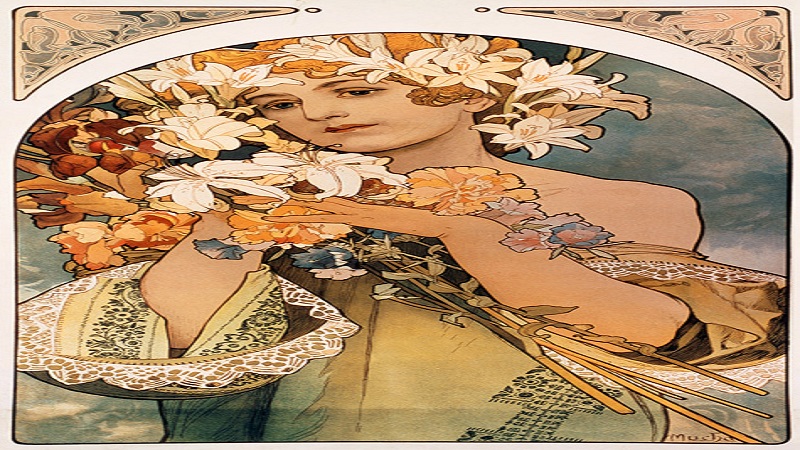People widely celebrate Alfons Maria Mucha, a name synonymous with Art Nouveau, as one of the most influential and recognizable artists of his time. His work, characterized by flowing lines, intricate detail, and ethereal women, helped define an entire artistic movement. Born in what is now the Czech Republic, Mucha contributions to the worlds of graphic art, painting, and design left an indelible mark on both European and global culture. This article delves into the life, artistic style, and lasting legacy of Alfons Mucha, a man whose work transcended time and continues to inspire contemporary design.
Early Life and Education: A Journey to Paris
Alfons Mucha was born on July 24, 1860, in the small town of Ivančice, located in what is now the Czech Republic. His artistic inclinations emerged early, despite his family’s limited means. He showed a profound talent for drawing and painting, leading him to seek education in the arts. Mucha initially struggled to gain formal artistic training, and his early career was marked by rejections from art academies.
Undeterred, Mucha moved to Vienna, where he worked as a scene painter for theaters. This experience exposed him to the burgeoning world of art and design in the Austro-Hungarian Empire. However, it was his move to Paris in 1887 that marked the beginning of his rise to fame. Paris, at the time, was the epicenter of artistic innovation, and Mucha immersed himself in the vibrant cultural scene.
He studied at the Académie Julian and the Académie Colarossi, honing his skills while supporting himself through various odd jobs. These formative years in Paris were crucial for Mucha, as they exposed him to the different styles and trends of European art, including Symbolism and Japonisme, which would later influence his own unique style. look at finalizeit
The Breakthrough: Sarah Bernhardt and “Gismonda”
The story goes that Mucha was in the right place at the right time, filling in for a regular poster artist during the holiday season.
Mucha’s design immediately captivated Bernhardt, the most famous actress of her time. His poster radically departed from the typical theatrical posters of the time, which often relied heavily on text and lacked visual elaboration
Mucha’s design for Gismonda featured a tall, slender figure of Bernhardt adorned in a flowing gown, surrounded by intricate patterns and floral motifs. The poster’s vertical format, soft colors, and elaborate detailing created an image of grace and elegance, turning the poster into a work of art in its own right. The success of Gismonda launched Mucha’s career and secured a six-year contract with Bernhardt, during which he designed posters, costumes, and stage sets for her productions.
The Birth of Art Nouveau: Defining a Movement
Mucha’s style, often referred to as “The Mucha Style,” became synonymous with the Art Nouveau movement. Though he never officially embraced the term “Art Nouveau,” Mucha’s work epitomized its aesthetic principles. Art Nouveau, which means “New Art” in French, emerged in the late 19th century as a reaction against the academic art and industrialization of the time. It was characterized by organic forms, flowing lines, and the incorporation of natural elements like flowers and plants.
Mucha’s work perfectly embodied these qualities. His designs were filled with lush, intricate patterns, sinuous lines, and a strong focus on decorative elements. He often depicted beautiful, idealized women with long, flowing hair, surrounded by ornate floral motifs, halos, and intricate details. These figures, known as the “Mucha woman,” became a hallmark of his art and a symbol of the Art Nouveau movement itself.
Mucha’s work extended beyond posters. He created a wide range of decorative objects, including calendars, book illustrations, jewelry, and furniture designs, all of which were infused with his distinct style. His ability to combine fine art with commercial design made him a pioneer in the world of applied arts.
The Slav Epic: A Nationalist Vision
While people best know Mucha for his contributions to Art Nouveau, one of his most ambitious projects was the Slav Epic, a series of twenty monumental paintings depicting the history and mythology of the Slavic people.
Mucha began working on the Slav Epic in 1910, and it became his life’s passion, taking nearly two decades to complete.
Mucha strong sense of Slavic identity and his desire to promote the cultural history of his people inspired the series.
The paintings, some of which are as large as six by eight meters, depict key moments in the history of the Slavs, from early pagan times to the establishment of modern Slavic nations. The Slav Epic was both a personal and political statement for Mucha, who believed that art could play a role in shaping national identity.
Mucha donated the entire series to the city of Prague in 1928, hoping they would house it in a dedicated building. However, the Slav Epic encountered numerous challenges over the years, including its storage during World War II and a long-standing debate over how to properly exhibit it.
Despite these difficulties, the Slav Epic remains one of Mucha’s greatest legacies, showcasing his talent not only as a decorative artist but also as a serious historical painter.
A Lasting Legacy: Influence and Inspiration
Alfons Mucha influence on the world of art and design cannot be overstated. His work helped define the visual language of Art Nouveau, a movement that left a profound impact on everything from architecture to fashion. Mucha decorative posters, particularly his depictions of women, became cultural icons, and his style has remained popular well into the 21st century.
Mucha approach to art was revolutionary in that he blurred the lines between fine art and commercial design. He believed that art should be accessible to everyone and sought to elevate everyday objects through his designs.
This philosophy is evident in many of his posters, which, originally created for advertising purposes, now receive recognition as fine art and are displayed in museums around the world.
His work also influenced the later development of graphic design, particularly in the use of typography, composition, and ornamentation.
Today, Mucha’s influence appears in a wide range of artistic disciplines, from illustration and tattoo design to contemporary fashion and interior decoration.
The Man Behind the Art: Mucha Personal Philosophy
Though many associate him with the glamorous and decorative world of Art Nouveau, Mucha’s personal philosophy and worldview were deeply spiritual and idealistic.
He believed that art had a higher purpose beyond mere decoration. His artwork often reflected his belief in the unity of all things and the connection between the material and spiritual worlds.
Mucha idealism also extended to his views on Slavic nationalism. He was a strong supporter of Czech independence and was involved in political movements aimed at promoting Slavic culture and unity. Mucha dedication to his national identity is evident in both his art and his life. His patriotism showed in his decision to return to his homeland in 1910 after achieving international fame, dedicating the rest of his life to projects that celebrated Slavic history and culture
The Final Years: World War II and Legacy
In the final years of his life, Mucha witnessed the rise of political tensions in Europe, culminating in the outbreak of World War II. Mucha nationalistic and Freemason affiliations made him a target for the Gestapo during the Nazi occupation of Czechoslovakia.
Mucha passed away on July 14, 1939, shortly after his release. His death marked the end of an era, but his legacy lived on through his art. The Mucha Museum in Prague, dedicated to his life and work, attracts visitors from all over the globe, while his posters and designs remain popular with collectors and enthusiasts alike.
Conclusion: Alfons Mucha’s Enduring Influence
Alfons Mucha was more than just a master of decorative art; he was a visionary who used his talents to shape both artistic movements and national identity. His ability to create art that was both beautiful and meaningful ensured that his work transcended the boundaries of time and geography. Mucha’s contributions to Art Nouveau have left an indelible mark on the world of art and design, and his legacy continues to inspire new generations of artists and designers. Whether through his iconic posters, the monumental Slav Epic, or his dedication to his cultural heritage, Alfons Mucha remains a towering figure in the history of modern art.


